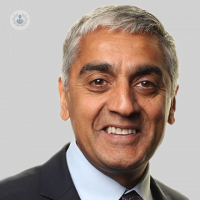How can sports cardiologists help athletes?
Written by:Sport and exercise are important for a healthy heart, but some people are prone to sudden cardiac arrest, the most common medical cause of death in athletes. Leading London-based cardiologist, Professor Sanjay Sharma discusses the role of sports cardiologist in the prevention of sudden death in sportspeople. He discusses how an athletic heart differs, what the most common heart-related symptoms athletes suffer from are, and how they are assessed for cardiovascular conditions.

What do sports cardiologists do?
One of the main aims of sports cardiology is to identify athletes who may have a cardiac disorder that could predispose to a sudden cardiac death. Sports cardiologists, like myself, do this by cardiovascular screening. We may identify an athlete with a serious disorder who aspires to continue to train and compete. In such cases, we identify their risks and then give them an appropriate exercise prescription that allows them to perform safe exercise.
As things have gone on over the last two decades, we're beginning to realise that sometimes predisposed individuals who exercise excessively may develop rhythm disturbances such as atrial fibrillation. Our job is to try and advise those people how they could reduce their risk of atrial fibrillation or how we could treat it. Sports cardiology is quite an evolving field that is responsible for ensuring that people engage in exercise, including competitive sport, but do so in a safe and sound manner.
How does an athletic heart differ from a non-athletic heart?
People who exercise intensively for four hours or more undergo a constellation of structural and functional changes in the heart that allows very large volumes of blood to be pumped around the body for a prolonged period. For example, when someone is sitting down, they're only pumping five litres of blood around the body but when they're exercising intensively this goes up to about 25 to 30 litres per minute.
There are only two ways the heart can do this; it can either increase its rate or increase its size. The maximal heart rate that anyone can achieve is governed by their age and the general equation is that the maximal heart rate is 220 minus their age. Very few individuals can exceed that heart rate. The only way to increase cardiac output is to increase heart size. In this respect, people who exercise intensively have about a 10% increase in the chamber size of the heart, that is the ventricles or the atria, and about a 10 to 20% increase in the thickness of the wall of the heart muscle. In these people the heart is also very efficient at filling up with blood fill contracting more vigorously compared with sedentary people. The increase in cardiac output is largely a function of a combination of a bigger heart that can fill more efficiently and can contract more effectively, even during high heart rates.
What are the most common heart diseases and conditions that athletes experience?
Firstly, sudden death in sport is uncommon affecting about one in fifty thousand athletes. The causes of death are very dependent on the age of that individual. In people age under 35 the most common causes are genetic or congenital abnormalities that affect the heart muscle or the electrical tissue. Once an individual is over 35, by far the most common cause of sudden death is atherosclerotic coronary artery disease or blocked arteries.
Athletes who experience chest discomfort during exercise, disproportionate breathlessness, palpitation, light headedness during exercise or loss of consciousness should be investigated for these conditions.
Transient palpitations such as the odd thump in the chest are relatively common and are due to extra beats in the chest, which may occasionally have serious reason. Some athletes often faint and that may not be necessarily serious. Feeling faint in an athlete is relatively common because they have slow heart rates and a low blood pressure, and if they push themselves very hard and become dehydrated sometimes these individuals can faint. We've got to be able to differentiate between a serious faint that may be due to a serious heart fault and a simple faint that may be due to a low heart rate and blood pressure in young people.
There are certain valve problems that are common in the general population such as a bicuspid valve and a mitral valve prolapse. These types of valvular faults are present in one to two percent of the general population and in many cases, we often advise individuals who are diagnosed with these valvular problems who want to exercise regularly.
What are the most important demographic factors that sports cardiologists assess?
When we're looking at the electrical tracing (ECG) in an athlete or examining the heart size, we have to take into account the age, the sex, the ethnicity of the individual and the type of sport that the person may be engaging in. All of these factors really play a very important role in how the heart adapts.
For example, when we're looking at structural changes on the echocardiogram, the most profound changes usually occur in adult male individuals who are engaging in endurance sports such as long-distance running, long distance cycling, triathlon, rowing, or canoeing. These are the sort of people that get the biggest and the slowest hearts. It's important to note that we rarely see this in adolescent individuals or in females.
The other thing that we need to take into account is the ethnicity of the individual because individuals originating from Africa or the Afro-Caribbean area often have marked repolarisation changes on the ECG which can sometimes simulate serious heart diseases or even a heart attack. One has to be aware of those changes when assessing these individuals.
Once we've established these factors, we assess the cardiac structure, looking at the thickness of the heart muscle and the exact size of the ventricles. We often do an exercise test to look at the functional capacity of that individual but that depends on what’s been found in our preliminary investigations.
How do sports cardiologists provide preventative care?
One of the fundamental aspects of sports cardiology is to prevent sudden cardiac death and we do this through screening. These screening practices vary from country to country and from sport to sport. If we look at the United States, for example, the screening process is relatively basic and cheap. It involves taking a history pertaining to symptoms of heart disease such as chest pain, breathlessness that is disproportionate to the amount of exercise being performed, palpitation or dizziness, or even a family history of premature sudden death as many of these conditions are genetic. There is a limited physical examination which involves listening for murmurs, checking for the blood pressure or looking for something called the Marfan syndrome, which is a collagen disorder that can cause dilatation and dissection of the aorta.
In Europe, screening also involves a cardiac investigation, namely a 12-lead ECG. The ECG is effective at picking up electrical faults of the heart such as Wolff-Parkinson-White syndrome, long QT syndrome and other repolarisation changes that may make us think of cardiomyopathy. Some sporting organisations that are financially well endowed, such as elite football, are also adding an echocardiogram which looks at cardiac structure and function. These are the basic methods by which we try to screen young individuals.
The difficulty really is in the older population, aged 35 or more who are participating in endurance runs or triathlons. An ECG or an echocardiogram will not pick up a significant proportion of those with coronary artery disease and the tests that are available are relatively expensive and not practical at mass level because we just don't have the resources. In such cases, we have a relatively pragmatic approach; if these people, who are not exercising habitually and have either cardiac symptoms or risk factors for cardiac disease such as diabetes, obesity, or high blood pressure, wish to engage in vigorous exercise then we recommend that they do undergo a thorough assessment with an ECG, echocardiogram, an exercise stress test or even a CT coronary angiogram.
If you are interested in booking a consultation with Professor Sanjay Sharma to discuss concerns about your cardiovascular health, you can do so by visiting his Top Doctors profile.


